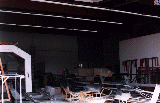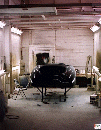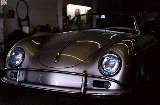 I visited Intermeccanica in the summer of 1995 and found it a relatively small
place containing, among the machinery and equipment, several quality automobiles
in various stages of construction and some expensively-looking components.
I visited Intermeccanica in the summer of 1995 and found it a relatively small
place containing, among the machinery and equipment, several quality automobiles
in various stages of construction and some expensively-looking components.
 I visited Intermeccanica in the summer of 1995 and found it a relatively small
place containing, among the machinery and equipment, several quality automobiles
in various stages of construction and some expensively-looking components.
I visited Intermeccanica in the summer of 1995 and found it a relatively small
place containing, among the machinery and equipment, several quality automobiles
in various stages of construction and some expensively-looking components.
 This curtained-off section of the
shop, located at the back, houses the jigs on which each fibreglass body and
frame/chassis (epoxy painted and rust-proofed) are attached. The shell visible
in this picture is what it appears, it is for a replica of the VW Kubelwagen
which the firm has just begun producing. Naturally it is mounted on a chassis
designed in-house and is made to the usual high standards of Intermeccanica.
This curtained-off section of the
shop, located at the back, houses the jigs on which each fibreglass body and
frame/chassis (epoxy painted and rust-proofed) are attached. The shell visible
in this picture is what it appears, it is for a replica of the VW Kubelwagen
which the firm has just begun producing. Naturally it is mounted on a chassis
designed in-house and is made to the usual high standards of Intermeccanica.
 The bodies are painted with
Glasurit acrylic urethane non-metallic or the optional metallic clear and
pearl coat in this section. Then they are wet sanded and polished for about
60 hours. But before being painted, each body (including doors, hood, etc.,
of course) and frame/chassis are heated in an oven and thus become one
monocoque unit.
The bodies are painted with
Glasurit acrylic urethane non-metallic or the optional metallic clear and
pearl coat in this section. Then they are wet sanded and polished for about
60 hours. But before being painted, each body (including doors, hood, etc.,
of course) and frame/chassis are heated in an oven and thus become one
monocoque unit.
 Here, somewhere in the main premisses
where all the components are fitted to each body/chassis monocoque unit, the
VDO-instrument-equipped close-to-completion dashboard can be clearly seen.
The leather steering wheel (a wooden one is also available) comes from Nardi
and the grab-handle is a neat option.
Here, somewhere in the main premisses
where all the components are fitted to each body/chassis monocoque unit, the
VDO-instrument-equipped close-to-completion dashboard can be clearly seen.
The leather steering wheel (a wooden one is also available) comes from Nardi
and the grab-handle is a neat option.
 Testing out the optional fog
lights?
Testing out the optional fog
lights?
 Peering under the front wheel well
one can find the dual circuit disc (drum at rear, disc optional) brakes and
the trailing arms and and torsion bars comprising the independent
suspension.
Peering under the front wheel well
one can find the dual circuit disc (drum at rear, disc optional) brakes and
the trailing arms and and torsion bars comprising the independent
suspension.

 The optional Porsche 356 A style
bumper overriders and guards visible on this particular example are one of
the more pricey propositions at over $2000.
The optional Porsche 356 A style
bumper overriders and guards visible on this particular example are one of
the more pricey propositions at over $2000.
 I spent a long time staring at this
metallic-silver example, also pictured above. It is extremely beautiful and
is most likely going to spend its life in Japan, where over 50% are exported
each year. One can be easily fooled into thinking that the body is made from
metal but it is really glassfibre.
I spent a long time staring at this
metallic-silver example, also pictured above. It is extremely beautiful and
is most likely going to spend its life in Japan, where over 50% are exported
each year. One can be easily fooled into thinking that the body is made from
metal but it is really glassfibre.
Both the Roadster 356/RS and Roadster Turbo are powered by a 72bhp 1600cc
dual-port Volkswagen-sourced motor with a 4-speed manual transmission. A
3-speed Borg-Warner transmission and a 87bhp 1600cc Super 90 or a 140bhp
2200cc high-performance engine are optional. As mentioned earlier, the
chassis is a box section steel tube perimeter frame with side members.
Alterations to the rear suspension crossmember allows the engine and
transmission to be mounted a few centimetres more forward than on the
original 356, improving handling substantialy. More and more improvements
over the original Porsche are constantly being made due to Henry and Frank
Reisner's belief that current technology should be employed to make driving
these awesome roadsters an even greater pleasure.